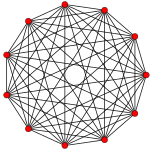29:
60:
278:
300:, and contains 1/3 of its 165 faces. Thus it can be drawn as a regular figure in 10-space, although then its hemi-icosahedral cells are skew; that is, each cell is not contained within a flat 3-dimensional
175:
326:- regular hyperbolic honeycomb with same Schläfli type, {3,5,3}. (The 11-cell can be considered to be derived from it by identification of appropriate elements.)
249:
It has symmetry order 660, computed as the product of the number of cells (11) and the symmetry of each cell (60). The symmetry structure is the abstract group
34:
The 11 hemi-icosahedra with vertices labeled by indices 0..9,t. Faces are colored by the cell it connects to, defined by the small colored boxes.
264:, who constructed it by pasting hemi-icosahedra together, three at each edge, until the shape closed up. It was independently discovered by
349:
250:
189:
413:
389:
110:
377:
282:
323:
228:
382:
301:
203:
261:
243:
103:
345:
231:
96:
43:
396:
265:
239:
54:
28:
181:
407:
91:
337:
220:
59:
390:
Isama 2007, Texas A&m hyper-Seeing the
Regular Hendeca-choron. (= 11-Cell)
297:
286:
235:
365:
The
Classification of Rank 4 Locally Projective Polytopes and Their Quotients
313:
277:
253:
of the 2-dimensional vector space over the finite field with 11 elements L
246:{3,5,3}, with 3 hemi-icosahedra (Schläfli type {3,5}) around each edge.
354:
318:
364:
296:
contains the same number of vertices and edges as the 10-dimensional
268:
in 1984, who studied its structure and symmetry in greater depth.
18:
26:
378:
J. Lanier, Jaron’s World. Discover, April 2007, pp 28-29.
113:
242:. It has 11 vertices, 55 edges and 55 faces. It has
359:
169:
361:, Annals of Discrete Mathematics 20 pp103–114.
8:
164:
155:
142:
130:
117:
114:
388:, Carlo H. Séquin & Jaron Lanier, Also
170:{\displaystyle \{\{3,5\}_{5},\{5,3\}_{5}\}}
21:
397:"Explanations Grünbaum-Coxeter Polytopes"
158:
133:
112:
386:Hyperseeing the Regular Hendecachoron
7:
344:, Cambridge University Press, 2002.
14:
276:
58:
27:
251:projective special linear group
209:
199:
180:
102:
90:
82:
74:
66:
49:
39:
1:
260:It was discovered in 1977 by
289:with 11 vertices, 55 edges.
232:abstract regular 4-polytope
44:Abstract regular 4-polytope
16:Abstract regular 4-polytope
430:
342:Abstract Regular Polytopes
367:, 2003, Michael I Hartley
236:four-dimensional polytope
283:Orthographic projection
171:
324:Icosahedral honeycomb
172:
238:). Its 11 cells are
111:
414:Regular 4-polytopes
395:Klitzing, Richard.
384:2007 ISAMA paper:
167:
272:Related polytopes
217:
216:
97:hemi-dodecahedron
421:
400:
336:Peter McMullen,
280:
266:H. S. M. Coxeter
240:hemi-icosahedral
176:
174:
173:
168:
163:
162:
138:
137:
62:
55:hemi-icosahedron
31:
19:
429:
428:
424:
423:
422:
420:
419:
418:
404:
403:
394:
374:
355:Coxeter, H.S.M.
333:
310:
281:
274:
262:Branko Grünbaum
256:
193:
187:
154:
129:
109:
108:
104:Schläfli symbol
57:
32:
17:
12:
11:
5:
427:
425:
417:
416:
406:
405:
402:
401:
392:
380:
373:
372:External links
370:
369:
368:
362:
352:
332:
329:
328:
327:
321:
316:
309:
306:
273:
270:
254:
215:
214:
211:
207:
206:
201:
197:
196:
191:
184:
182:Symmetry group
178:
177:
166:
161:
157:
153:
150:
147:
144:
141:
136:
132:
128:
125:
122:
119:
116:
106:
100:
99:
94:
88:
87:
84:
80:
79:
76:
72:
71:
68:
64:
63:
51:
47:
46:
41:
37:
36:
24:
23:
15:
13:
10:
9:
6:
4:
3:
2:
426:
415:
412:
411:
409:
398:
393:
391:
387:
383:
381:
379:
376:
375:
371:
366:
363:
360:
356:
353:
351:
350:0-521-81496-0
347:
343:
339:
335:
334:
330:
325:
322:
320:
317:
315:
312:
311:
307:
305:
303:
299:
295:
292:The abstract
290:
288:
284:
279:
271:
269:
267:
263:
258:
252:
247:
245:
244:Schläfli type
241:
237:
233:
230:
226:
222:
212:
208:
205:
202:
198:
195:
185:
183:
179:
159:
151:
148:
145:
139:
134:
126:
123:
120:
107:
105:
101:
98:
95:
93:
92:Vertex figure
89:
85:
81:
77:
73:
69:
65:
61:
56:
52:
48:
45:
42:
38:
35:
30:
25:
20:
385:
358:
341:
338:Egon Schulte
293:
291:
275:
259:
248:
224:
218:
33:
221:mathematics
331:References
298:10-simplex
287:10-simplex
210:Properties
314:5-simplex
229:self-dual
204:self-dual
188:Abstract
186:order 660
408:Category
308:See also
302:subspace
213:Regular
83:Vertices
22:11-cell
319:57-cell
294:11-cell
225:11-cell
70:55 {3}
348:
257:(11).
223:, the
227:is a
75:Edges
67:Faces
50:Cells
346:ISBN
200:Dual
194:(11)
40:Type
285:of
219:In
86:11
78:55
53:11
410::
357:,
340:,
304:.
399:.
255:2
234:(
192:2
190:L
165:}
160:5
156:}
152:3
149:,
146:5
143:{
140:,
135:5
131:}
127:5
124:,
121:3
118:{
115:{
Text is available under the Creative Commons Attribution-ShareAlike License. Additional terms may apply.


